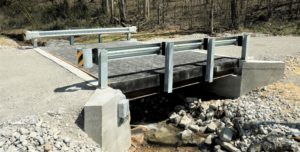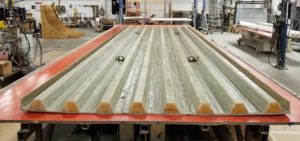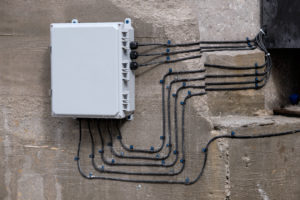Due to the use of technologically advanced composites, the bridge deck system requires less installation time, reduces energy costs during construction and has a 100-year lifespan.
On the surface, it looks like any of the thousands of small, narrow two-lane bridges across America.
But a new, high-tech bridge in north-central Tennessee is equipped with a fiber-reinforced polymer (FRP) composite material bridge deck embedded with fiber optic sensors. It replaced a damaged, decades-old concrete crossing which, like thousands of rural, low-volume bridges across the state and nation, was rated structurally deficient and outdated.

OPEN TO TRAFFIC – The recently completed lightweight bridge deck system in Morgan County, Tenn., required less time to install than a traditional concrete bridge, reducing energy costs and on-site constructions costs. Since the bridge has a 100-year lifespan, the county will save money on repairs in the long term.
According to the American Society of Civil Engineers, about 8 percent of the more than 617,000 bridges in the U.S. are structurally deficient and need repair. FRP composites offer a low-cost, low-maintenance option and the new structure in rural Tennessee and is intended to demonstrate the benefits of composite materials for rural bridgework.
“This composite bridge has already made a positive impact on Morgan County,” said Morgan County Highway Superintendent Joe Miller, who added county officials were looking for a low-maintenance bridge that could be installed fast and at a lower cost than traditional methods. “We have numerous bridges within the county and hundreds across the state that are in need of repair and could benefit from this technology.”

(IACMI / Shawn Millsaps)
ONE DAY INSTALLATION – The bridge decking was manufactured in a controlled environment offsite, improving the quality of the structure and reducing the number of days a bridge must be closed to traffic. Completed bridge sections were transported to job site and installed in one day using a forklift.
For Morgan County, the lightweight, easy-to-install bridge comes at no cost, courtesy of the composites industry. Working together under the umbrella of the Institute for Advanced Composites Manufacturing Innovation, or IACMI—The Composites Institute®, almost a dozen private companies led by Tennessee-based Composite Applications Group (CAG) partnered with industry organizations and university researchers to make the composite bridge a reality.
Developed by Structural Composites Inc. (SCI), the 16-feet-long and 25-feet-wide bridge deck is engineered for high-strength and is 90 percent lighter than concrete. It has two 8-by-25-foot corrosion resistant FRP deck panels that were fabricated off-site in a controlled environment. Because the completed bridge sections were so lightweight, they could be transported to the bridge site and installed in one day using a forklift, reducing installation time and energy costs by requiring less construction equipment for on-site preparation.

HIGH-STRENGTH FRP DECK PANELS – Developed by Structural Composites Inc., the bridge surface is comprised of two 8-by-25 foot fiber-reinforced polymer (FRP) deck panels that are engineered for high-strength, corrosion resistant and 90 percent lighter than concrete.
IACMI Technology Manager John Unser, who is also vice president of program and project management for CAG, said composites have been used for bridge deck applications for more than 20 years and have exceeded all performance and safety standards set by the American Association of State Highway and Transportation Officials (AASHTO). But when it comes to composite bridge decking, he said, many transportation departments across the country, especially those from smaller jurisdictions, are not familiar with the technology.
IACMI and its industry partners are developing a comprehensive case study based on the Morgan County bridge project, including comparing total costs of a typical concrete bridge and one using an FRP bridge deck. Unser said the results will be shared with federal, state and local officials, transportation departments and the civil engineering community so FRP composites will be more a “known” to them.
University of Tennessee, Knoxville (UTK) researchers and engineering students from the Fibers and Composites Manufacturing Facility are part of the bridge partnership. They embedded smart fiber optic sensors developed by Luna Innovations into the bridge surface during production. These high-density sensors are being used to monitor the composite deck system over time to give critical performance and safety data, thus providing a sustainable solution for aging infrastructures such as bridges. In addition, wireless technology developed at UT is being utilized for monitoring the response of the bridge system and traffic counts remotely via cloud computing.

SENSOR BOX – University of Tennessee researchers embedded fiber optic sensors in the composite bridge decking during construction and will monitor long-term durability and performance via cloud computing.
“Lack of durability data is one of the major barriers of the adoption of novel and advance materials including carbon, basalt, or glass fiber reinforced polymeric composites in civil infrastructure,” said Dayakar Penumadu, the Fred N. Peebles Professor in the Tickle College of Engineering at UT and Characterization Fellow for Materials and Processing for IACMI.
Penumadu added, “this is a major obstacle for integrating new materials and structures quickly and thus require successful demonstration as being done through this IACMI project. Bridge decks are the most damage prone elements, and we are integrating smart sensors distributed throughout the composite bridge deck that will provide us valuable performance data with time for years to come.”
To learn more about the Morgan County bridge project and how FRP bridges offer a sustainable solution to the nation’s crumbling infrastructure, visit www.compositebridge.org.
Collaborative Partnership
Led by IACMI and CAG, a collaboration of private companies contributed expertise and materials such as adhesives, epoxies, coatings and resins, preforms and reinforcements to the Morgan County bridge project. These include SCI, McKinney Excavating Inc., Luna Innovations, Steffen Structural Engineering, Neel-Schaffer Inc., Interplastic Corporation, Engineered Bonding Solutions LLC, West System, Superior Fiberglass, METYX Composites and Compsys, Inc.
